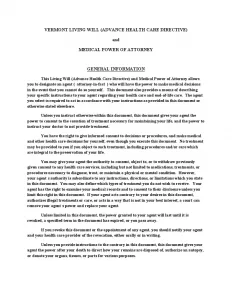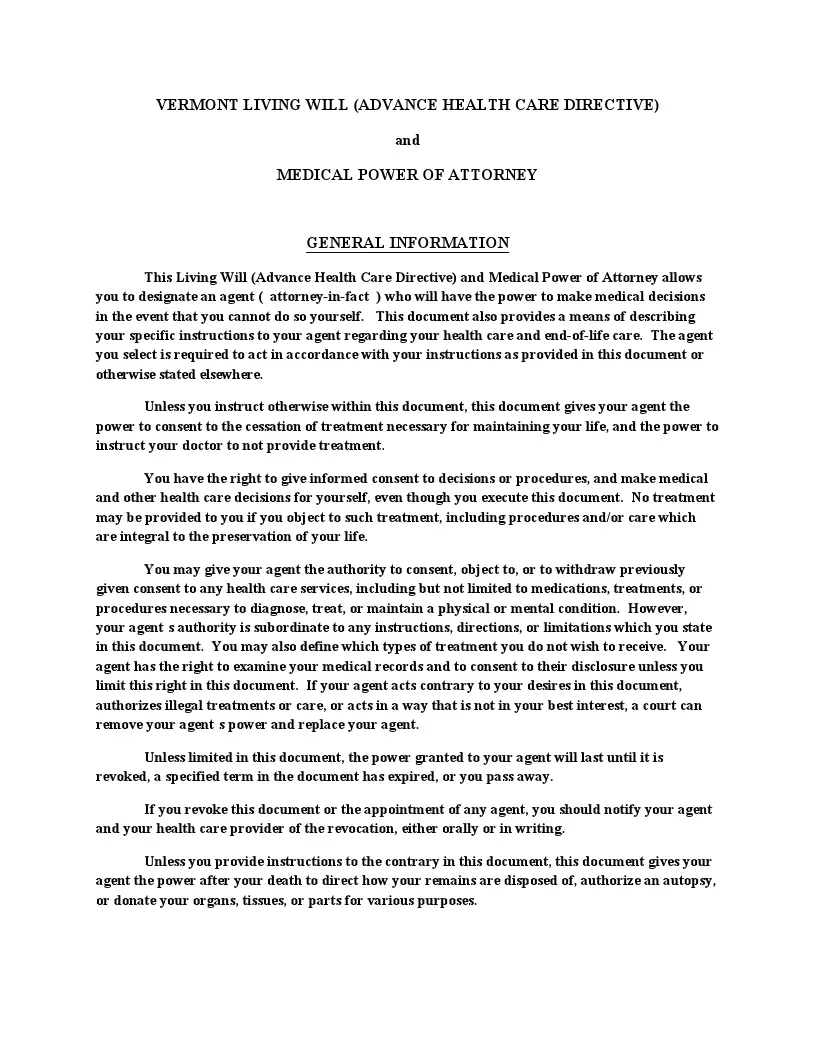Free Vermont Living Will Form
A living will form in Vermont is part of an Advance Directive for Health Care. This document specifies your preferences for medical treatment if you become incapacitated and are unable to communicate your wishes.
Creating a Vermont living will is an important step to ensure that your healthcare provider and family members know your preferences for treatment or care regarding medical treatments at the end of life. You can register your advance directive with the Vermont Advance Directive Registry to ensure that your wishes are easily accessible to healthcare providers. Registration is free and can be done online or by mail.
Signing Requirements and Laws
In Vermont, a living will, also known as an advance directive, must adhere to specific legal requirements to be valid. The Vermont Statutes Annotated (V.S.A.) Title 18, Chapter 231, provides the framework for these requirements. The person creating the living will (the principal) must sign the document. This signature confirms that the principal has willingly created the directive and understands its contents.
Two adults must witness the principal’s signature. These witnesses must be present when the principal signs the document or acknowledges the signature. The witnesses must also sign the document, attesting to the principal’s capacity and voluntary action. The witnesses must be adults who are not:
- The principal’s health care agent or alternate agent.
- The principal’s spouse, parent, adult child, or sibling.
- An employee of the health care facility where the principal is receiving care.
- Claim to any part of the principal’s estate upon their death.
According to 18 V.S.A. § 9704, a principal can suspend or revoke all or part of an advance directive, including the designation of an agent, at any time, whether they have capacity or not. Methods to revoke an advance directive include signing a statement, informing the clinician, or physically destroying the document.
Vermont Living Will Form Details
| Document Name | Vermont Living Will Form |
| State Form Name | Vermont Advance Directive |
| Signing Requirements | Two Witnesses |
| Validity Requirements | 18 V.S.A. § 9703 |
| Powers Limitation | 18 V.S.A. § 9707 |
| State Laws: Vermont Statutes Annotated, Title 18, Chapter 231 | |

Steps to Fill Out the Form
By carefully following these steps, you ensure that your Vermont Advance Directive is completed accurately, reflecting your medical care wishes and designating a trusted individual to make decisions on your behalf.
1. Personal Information
Start by entering your full name, date of birth, date signed, address, city, state, zip code, phone number, and email at the top of the form. Ensure all information is accurate to establish your identity.
2. Appointing Your Health Care Agent
In Part 1, choose and appoint a health care agent. Indicate whether their authority starts when you can no longer make decisions immediately or under specific conditions. Provide the agent’s full name, address, relationship, and contact information. You can also appoint alternate agents with the same details.
3. Other Involved Parties
In Part 2, list your primary doctor and any other individuals you want your agent to consult about your care. Also, specify who should not be consulted. Identify those allowed to receive information about your medical condition and those not entitled to challenge decisions about your care. If necessary, appoint a preferred guardian.
4. Statement of Values and Goals
In Part 3, describe your values and goals regarding your health care. Use this section to explain what is most important to you in medical care decisions, considering potential future health states and treatment success probabilities. This guidance helps your agent and health care providers understand your preferences.
5. End-of-Life Wishes
In Part 4, specify your end-of-life treatment preferences. Indicate if you want all possible treatments to extend your life or if you want to limit treatments like ventilators, tube feeding, or antibiotics. You can also note preferences for hospice care, pain management, and where you wish to die.
6. Other Treatment Wishes
Part 5 addresses wishes for specific treatments and situations, such as DNR orders, treatment trials during critical health crises, hospitalization preferences, and medical research or trial participation. Include mental health treatment preferences, such as consent to electroconvulsive therapy (ECT).
7. Waiver of Right to Request or Object to Treatment
In Part 6, if applicable, specify treatments you want or do not want, even against your future objections. This part requires careful consideration and additional signatures from your agent, clinician, and an authorized person to confirm your understanding and voluntary consent.
8. Organ and Tissue Donation
In Part 7, state your wishes regarding organ and tissue donation. Indicate if you want to donate any needed organs or specific ones or if you want your agent or another person to decide. If you do not wish to be an organ donor, state that.
9. Disposition of Your Body
In Part 8, provide instructions for the disposition of your body after death, such as burial or cremation preferences. You can appoint an agent to handle these arrangements or leave the decision to your family. Include any pre-made arrangements or preferences for autopsy.
10. Sign and Witness the Document
In Part 9, sign and date the document to make it legally binding. Have two adult witnesses sign and date the form, affirming that you appear to understand the directive and are free from duress. If you are in a healthcare facility, a third person must sign to confirm the explanation and your understanding.

Below are various other Vermont templates completed by our users. Try our simple builder to customize these forms to your preferences.
